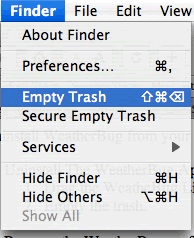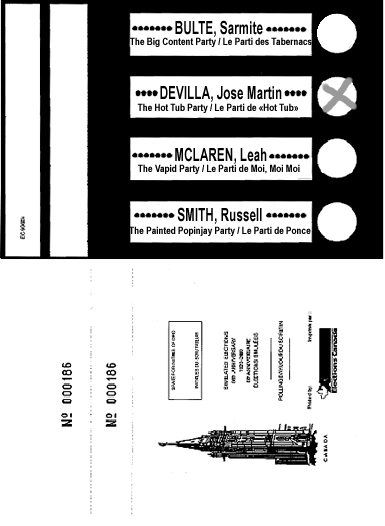 Time to Take Out the Trash!
Time to Take Out the Trash!
“Time to take out the trash!” I said when I got home from work this evening. And because the nearest polling station to my place just happened to be in the lobby of our building, I did just that, after which I dropped off the garbage in the bulk garbage area. It took longer for me to go to the corner store for some milk than it did to vote.
Voting in Canada Made Easy
For the benefit of my readers, the majority of whom are American, here’s a very quick primer on how voting works here.
We don’t vote directly for the Prime Minister. Rather, we vote for the MP — that is, Member of Parliament — to represent our electoral district, which is called a riding. The closest analogue to an MP in the American system is a Congressman or Congresswoman.
The winning candidate for the riding is determined by a “first past the post” system, which simply means that the candidate who gets the most votes win, regardless of how slim the margin of victory. That winner becomes the riding’s MP and gets a seat in the House of Commons, one of three parts of Parliament (there’s also the Crown — represented by the Governor General — and the Senate, who are appointed by the Governor General based on recommendations by the Prime Minister).
The leader of the winning party — the one with the most seats in Parliament — then becomes the Prime Minister. However, there’s a catch: under the Parliamentary system (more accurately referred to as a Westminster System), merely having the most seats isn’t enough. If the winning party has more than 50% of the seats in the House of Commons, it has a majority government and generally enjoys the benefits of being the ruling party. However, if the winning party more seats than any other single party but has less than 50% of the seats, it has a minority government.
Minority governments need to bargain with or form coalitions with other parties in order to pass legislation; they are also vulnerable to motions of no confidence, which if passed, force a general election (which is why this election is taking place). There are 308 seats in the House of Commona, which means that the winning party need 155 of them to have a majority government.
The Ballot
Voting is done on paper ballots. None of this butterfly ballot or Diebold possibly–rigged voting machine nonsense. It’s good ol’ paper, using a standard format that is used nationwide. Pictured below is a sample ballot image from Elections Canada (I took it from this page), with some fake candidates (the other three names are of people whom I’ve excoriated in this blog).

The top part of the sheet is the ballot lists each candidate and his or her affiliation. The candidates are listed in ascending alphabetical order based on surname. You vote for your candidate by placing an X in the circle corresponding to your choice using the golf pencil provided.
Here’s the official explanation of the ballot from Elections Canada (which also explains that yes, it is illegal to eat a ballot):
Before the deputy returning officer gives a person a ballot, he/she initials it. A numbered counterfoil is attached to each ballot. The elector must thereafter proceed directly to the voting compartment, mark the ballot paper, fold it as instructed by the deputy returning officer and return it to the deputy returning officer (the form of the ballot and the voting procedure are governed by ss. 116 and 150-53 of the Canada Elections Act).
When the voter returns the ballot, the deputy returning officer verifies that it is the same one that was handed to the elector. The deputy returning officer then removes and destroys the counterfoil, and returns the ballot to the elector to deposit in the ballot box or, at the elector’s request, deposits it in the ballot box.
When the polls close, ballots are counted by hand in front of the candidates’ representatives.
The process is described quite simply in Elections Canada’s School Elections Officer Guide, which features a student council election process modelled closely after the real thing.
10 replies on “Voting in Canada, Explained”
What? It’s illegal to eat the ballot? What if you’re really hungry?
That’s what Tim Horton’s is for! Wasn’t that a question on your citizenship test?
It’s even funnier if you know why they actually wrote this up 😉
The Crown/Governor General is not part of Parliament. S/he is separate from Parliament altogether. Only the House of Commons and the Senate form Parliament.
The Guide to the Canadian House of Commons and Wikipedia say otherwise.
I think Wikipedia may be wrong here. The Govenor General is the “representative of the Queen / King” but not part of the Parliament as far as I know, at least not in any “acting” form.
When the PM is recommending people for the Senate the GC is approving them on behalf of the King / Queen, but this is not really a parliamental approval process.
The Guide to the Canadian House of Commons — the site with the gc.ca (Government of Canada) domain — says:
To be completely certain your vote is counted, that X should be completely inside the circle. As long as it is unambiguous, it should not be a problem, but the circle is big enough that you should have no problem restraining yourself!
An X, a cros, checkmark, line, dor, or filling in the circle is acceptable, as long as it is in ONE CIRCLE ONLY.
Writing over the persons name, initialing the ballot, or marking it in a manner other then listed above will have it counted as “spoiled”.
Hi have a nice day! (if you can)